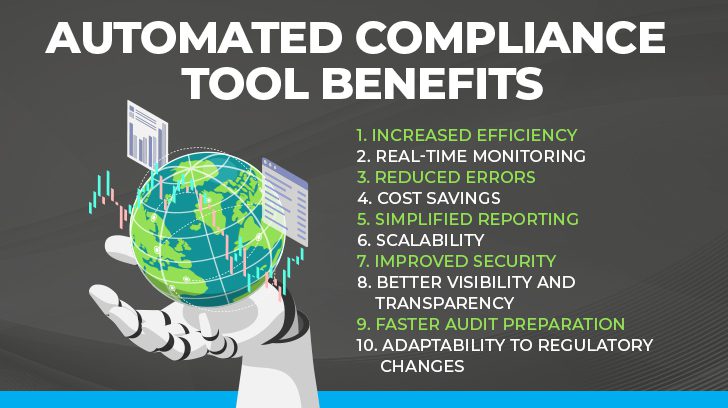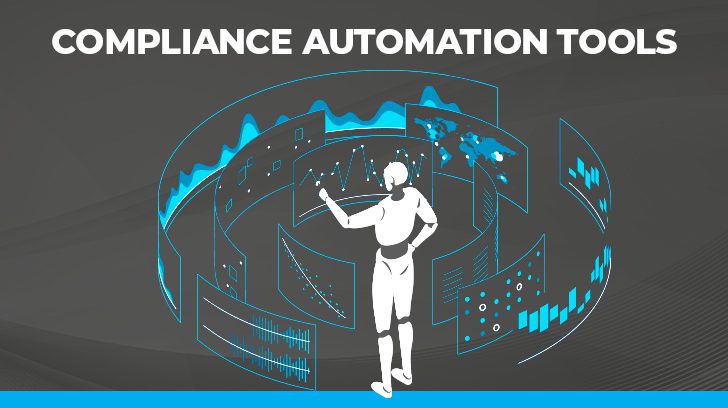Who likes dealing with regulatory compliance? It’s not the most fun or popular task for organizations to deal with. Yet we live in a world with increasing risks related to information security, increasing regulation, and less time to commit to dealing with these factors. With the proliferation of artificial intelligence (AI) and compliance automation tools coming to market, the value proposition is simple: spend less time focusing on compliance and let compliance automation tools and AI do the heavy lifting for you.
Most traditional audits happen annually. In a traditional audit, auditors collect point-in-time evidence as well as samples over time to test controls and determine whether they are designed and operating effectively. Then an auditor confirms whether or not a given regulatory framework’s requirements are met by the controls that were tested.
What is the History of Compliance Automation Tools?
Continuous compliance tools have been in development and use for approximately a decade, with significant evolution in the past five years due to advancements in cloud computing, automation, and artificial intelligence.
The sections below provide an overview of compliance automation tool history.
Early 2010s: Foundational Development
- Early continuous compliance tools emerged to address the growing complexity of compliance in cloud environments.
- Tools focused on specific frameworks like SOC 2, ISO 27001, and HIPAA, but lacked the advanced automation and integration seen today.
Mid-2010s: Adoption and Maturity
- As organizations moved to the cloud, the need for real-time monitoring and automation became more apparent.
- Companies like Vanta, Drata, and Tugboat Logic began to innovate, providing solutions for security and compliance automation.
Late 2010s: Expansion and Refinement
- Continuous compliance tools became more feature-rich, integrating with CI/CD pipelines and offering automated evidence collection.
- Growth in venture capital investment fueled the development of tools with broader framework support and enhanced user experience.
2020s: Mainstream Adoption
- The COVID-19 pandemic accelerated cloud adoption and remote work, driving demand for automated compliance tools.
- AI and machine learning have been increasingly incorporated to provide predictive analytics, automated remediation, and more efficient compliance processes.
- Tools now cover a wide range of standards and regulations, offering solutions for startups to enterprises.
While the concept of continuous compliance is not new, the tools to achieve it have only become viable and sophisticated in the past decade. They continue to evolve, aiming to simplify regulatory adherence and enhance organizational security.

Can a Compliance Automation Tool Replace a Human?
Not fully, but less human involvement may be needed once tools are configured properly.
What Can Compliance Automation Tools Do?
- Automate Repetitive Tasks:
-
- Automatically collect and organize compliance evidence (e.g., access logs, audit trails).
- Monitor systems for compliance violations and generate alerts.
- Schedule and manage recurring compliance checks.
- Ensure Consistency:
-
- Apply standardized frameworks (e.g., SOC 2, ISO 27001) uniformly across an organization.
- Maintain continuous monitoring to identify deviations from policies.
- Provide Insights:
-
- Generate reports for auditors and stakeholders.
- Offer dashboards that track compliance metrics in real time.
- Streamline Collaboration:
-
- Integrate with other tools (e.g., HR, IT, and cloud platforms) to centralize compliance efforts.
- Facilitate communication across departments for compliance-related tasks.
What Requires Human Involvement?
- Interpret Complex Regulations:
-
- Compliance requirements often involve nuanced legal and industry-specific standards that automation tools cannot fully interpret or customize.
- Strategic Decision-Making:
-
- Humans need to set compliance strategies, determine risk tolerance, and prioritize efforts based on business needs.
- Humans need to assess risks related to a given service or product and identify any unique controls that need to be in place to mitigate those risks.
- Address Edge Cases:
-
- Unique or unexpected situations often require human judgment to determine the appropriate course of action.
- Auditor Interaction:
-
- While automation tools prepare data, human professionals engage with auditors to explain processes, decisions, and context.
- Adapt to New Regulations:
-
- Implementing changes for new or revised regulations often requires human expertise to interpret and customize tools accordingly.
- Ethical Considerations:
-
- Compliance involves ethical and organizational values that tools cannot comprehend or enforce.
Key Takeaway
Compliance automation tools are not a replacement for human expertise but rather an enabler. They handle the heavy lifting of repetitive tasks and provide valuable insights, allowing humans to focus on higher-level responsibilities like decision-making, regulatory interpretation, and strategic planning. Together, humans and automation tools create a more efficient, effective, and scalable compliance process.
What is Compliance Automation?
Historically, continuous controls monitoring was more customized to each company’s unique environment. Today, many companies are leveraging cloud infrastructure like AWS and GCP which allows for more consistent approaches to continuous controls monitoring. Consistent approaches and sets of controls lend themselves to automation. The trend towards more consistent SaaS tooling has created a unique opportunity for monitoring tools to attempt to deliver automated compliance.

Can You Automate Regulatory Compliance?
Most of the compliance automation tools in use today include a vanilla set of best practice controls for monitoring compliance in AWS, GCP, and Azure against various regulatory frameworks. Depending on the product or service being provided, a vanilla set of best practice controls may be sufficient to address the risks related to providing the service. Other products and services are more complex and have unique risks that a vanilla set of controls may not address. It’s important for organizations leveraging compliance automation tools to assess whether or not the tool is evaluating all of the controls necessary to mitigate an organization’s unique set of risks.
For example, compliance automation tools do not know how sensitive the data is that is being stored in an organization’s databases. If an organization stores credit card data or personally identifiable information, there needs to be more stringent controls in place to address the elevated risk. Compliance automation tools allow for humans to categorize the importance of information assets and monitor them accordingly, but humans are needed to perform the prioritization and risk ranking of information assets. That highlights an important point about the limitations of automation in compliance.
Compliance Automation Tools Alone Are Not a Silver Bullet for Meeting Compliance Requirements
Compliance automation tools need to be configured and maintained over time for them to be effective. Some of our clients have purchased compliance automation tools and expected the tools to do all of the work related to compliance with little input. The tools change the nature of the compliance work, but they still require work to get the tools to work as intended. Organizations must integrate compliance automation tools with other tools that are in use, configure alerts and SLAs to meet internal requirements, and remediate alerts as necessary once the tool is correctly configured.

What Are the Benefits of Compliance Automation Tools?
Compliance automation tools can help make audits and auditors more efficient. They can also help companies monitor compliance over time with a given framework (e.g. SOC 2, ISO 27001, HIPAA).
Company Benefits
The value proposition of compliance automation is doing less with more. Let’s be honest, 9 out of 10 people hate compliance so the chance to make it less painful is a common reason to adopt a compliance automation tool. Compliance automation tools can allow fewer individuals to maintain an internal control environment and take action to correct control failures when they occur. Compliance automation tools can also help create a more secure IT environment by alerting staff when controls do not function as intended.
Audit Firm Benefits
Audit firms that leverage compliance automation tools can also realize benefits. These benefits can include increased audit efficiency and fewer staff required to complete an audit engagement. Similar to the automobile assembly lines, which allowed fewer people to create more, automated compliance tools can help one auditor perform more audits.
Rather than rely on the work of a staff auditor to collect evidence, a senior auditor can pull the required evidence directly from the compliance tool. This minimizes the need to have back and forth with clients regarding requests and allows the auditor to focus their questions on the evidence provided in the tool. Similar to filling in the blanks rather than starting from scratch or the compliance tool setting up the bowling pins and the auditor knocking them down.
What Are Some Features of Different Automated Compliance Tools?
- Policy and procedure creation – Companies can develop policies and procedures required by compliance frameworks. P+P creation tools can be a great starting point for small businesses or startups that have processes, but no documentation yet.
- Agents running on servers and workstations reporting continuously into a dashboard (e.g., OS patch status, antivirus up-to-date, and hard drive encryption).
- Ability to adopt a vanilla set of controls to meet audit requirements or develop a customized set of controls.
- Ability to map controls to control frameworks and export different reports depending on the framework.
- Risk assessment creation and remediation task tracking
- Security awareness training tracking
- Policy and procedure sign-off tracking
- Vulnerability identification and remediation
- Alerts related to performing key controls (e.g., access not removed for a terminated employee)
Are Automated Compliance Tools Worth the Cost?
No two companies’ risk profiles are exactly the same. Also, no two companies’ regulatory requirements or controls will be exactly the same either. As a result, each company must assess the potential value that automated compliance tools may add to their unique environment.
It’s not an apples-to-apples comparison to add the cost of an audit with automated tool subscription fees. The tools allow companies to maintain their controls and evidence in one place with fewer compliance resources. Automated compliance tools also help alleviate concerns that a company may not be ready for an audit. It’s easy for stakeholders to quickly log into tools and determine audit readiness status. For startups or small companies, a dedicated compliance resource is not always an option.

What Are the Risks Associated With the Use of Automated Compliance Tools?
- Functionality Risks:
-
- Tools might not function as intended, leading to incorrect or incomplete data.
- Integration issues (e.g., broken APIs) could affect reliability.
- Management Risks:
-
- Service organization management may misunderstand the tool’s role in internal controls.
- Over-reliance or misuse of compliance automation tools might result in ineffective controls.
- Competency Risks:
-
- Management may lack the expertise to properly implement and use compliance automation tools.
- A lack of expertise could hinder management’s ability to ensure proper control design and operating effectiveness.
- Audit Firm Risks:
-
- Buyer beware: While audit firms are not a direct risk of the use of compliance tools, many compliance automation tools have preferred auditors that they refer their customers to. Some of the preferred audit firms are charging fees that are 30% of the cost of similar audits historically. Audits using continuance compliance tools should be less expensive than traditional audits, however, 30% of the cost should raise eyebrows. Is an auditor double-checking what comes out of the tool and validating integrations with other tools to confirm they are working correctly?
- Super low fees from a preferred compliance automation tool auditor could indicate the firm is placing over-reliance on the compliance automation tools and not performing due diligence to make sure controls are actually in place and operating effectively.
- Audit firms need to be independent in fact and appearance of everyone as they serve the public. If a firm is a “partner” with an automated compliance tool, that could have the appearance of an independence conflict.
Choosing the Right Compliance Automation Tools for Your Organization
The number of companies using automated compliance tools is growing rapidly. Tools can allow startups and small businesses to focus more on growth and development while maintaining compliance without dedicating full-time compliance resources. Tools can also save money on audit fees if firms pass along savings for the efficiencies that tools create. That said, compliance tools may not work for every organization’s environment. It is important to consider your organization’s unique risks and processes in place and see whether they align with the functionality provided by automated compliance tools.
If you have questions about automated compliance tools or are interested in an audit please feel free to click the “Contact Auditor” button on this blog post.

Rob started with Linford & Co., LLP in 2011 and helps lead the HITRUST and ISO practices as well as performs SOC audits, NIST 800-171, and HIPAA assessments. He has spoken at Data Center World on compliance-related topics and has completed over 800 SOC examinations. He started his career as an IT auditor in 2003 with PwC in the Systems and Process Assurance group, and has worked in a variety of industries in internal audit as well as for the City and County of Denver.




